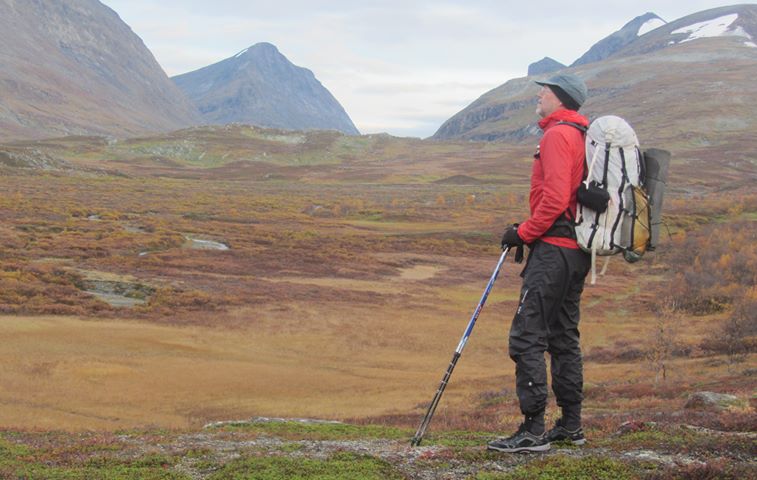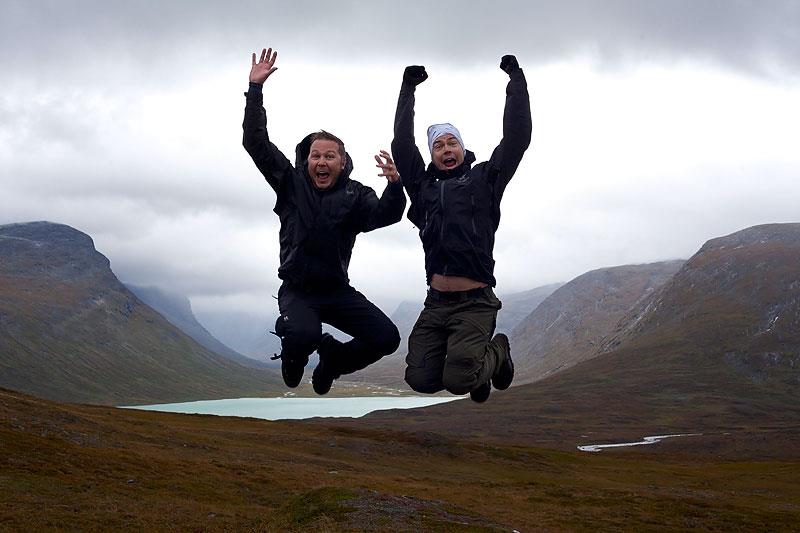Jörgen Johansson is known to many as the author of the book ‘Ultralight Hiking’ and has spent recent decades challenging the packing norms promoted by major outdoor retail chains. He has long held a special place in his heart for Jokkmokk and the Jokkmokk mountains, and worked long ago with Peter Segerström on a project in Jåhkågasska Sami village studying reindeer calves killed by predators. Jörgen is passionate about rethinking packing strategies while keeping things uncomplicated.
Jörgen, why should one pack lighter?
-Part of my mission is to demystify and simplify. Getting out into nature doesn’t need to be heavy, difficult, or dangerous. Sometimes I respond sarcastically to the question ‘why is my pack so heavy?’ by saying it’s because it’s full of fear – A large part of marketing plays on uncertainty and fear. It’s a bit exaggerated, but I think the industry is doing itself a disservice, says Jörgen.
In the book ‘Ultralight Hiking’, you coined the term “three for three”. What does that mean?
-The three heaviest items that form the foundation of packing are the backpack, tent, and sleeping bag – cutting off your toothbrush handle is silly, but with these three big items, you can save several kilos together, and once you’ve saved kilos, you can then move on to items where you can save hundreds of grams.
-It’s from this thinking that I coined the phrase “three for three”. That the three major components in your pack shouldn’t weigh more than three kilos together – that’s how you lay the foundation for light packing, says Jörgen and continues:
-Some people react to this and wonder how it’s possible. Then I explain that it’s not so remarkable and today it’s not even that extreme – there are those who are under 2 kg for the three major items. It just requires a bit more thought, but if you look at typical mountain packs, it’s not unusual for the three big items to weigh seven, eight or nine kilos, and then a hike that could be easy and enjoyable becomes strenuous for most people, says Jörgen.

The backpack is often the heaviest item you carry, and there can be several kilos difference for the same volume between different models:
-During a month-long hike through the Brooks Range in Alaska, I used a seventy-liter backpack that weighs one kilo when empty, and if I can manage such a long hike in Alaska with that backpack, one conclusion is that basically no one needs a heavier backpack for, say, hiking along the King’s Trail – yet most bestsellers in stores weigh over three kilos.
You almost exclusively hike in very light and low shoes. What do you say to those who claim you need sturdy boots?
-I usually say, ‘use what you have.’ You don’t need to buy expensive and heavy boots or Kevlar-reinforced pants for a regular, simple hike. Often it’s not so bad to get wet feet, and if you feel cold, there are waterproof socks.
-The most important thing, however, is not to have too heavy shoes or boots. It takes five times more energy to carry something on your feet than to carry it on your back.
Jörgen takes a brief pause and then continues:
-So regardless of what you choose, there’s a point in choosing the lightest option that does the job and works.
-If I were to go on a longer trip in the Jokkmokk mountains, I would never choose Gore-Tex boots because they’ll get wet pretty quickly and it will be difficult to dry them in the field. If you’re doing shorter distances and day trips with opportunities to dry in between, that’s different, thinks Jörgen.

In the outdoor world, there are often intense discussions between those who strive to pack light and those who think ultralight hikers expose themselves to risks and that you need sturdy tents and boots. Jörgen believes it’s important to understand that different types of hikers have different motivations.
-When I talk about lightweight packing and hiking, I think it’s important to describe what type of hiker you are. Are you a camp hiker or a long-distance hiker? It obviously affects the priorities you make. At one end, you have long-distance hikers who might walk the Pacific Crest Trail from Mexico to Canada and hike long distances every day – then it’s very important to reduce pack weight as much as possible.
-The other extreme is those who hike short distances and bring a sturdy tent and maybe a grill and good food – then the experience might be more about relaxing around the campfire and enjoying the stillness.
-And one isn’t more right than the other, it’s about what different people prioritize for different experiences. Problems arise when the camp hiker tries to tell the long-distance hiker what equipment they should have, or when the long-distance hiker tries to tell the camp hiker what’s best.
-Then we have the middle ground where most people are, but who only get knowledge about what camp hikers use – because that’s the image often conveyed by most outdoor stores, says Jörgen and continues:
-And this is where I feel I want to convey that there are alternatives that are lighter and still keep you just as dry, warm, and safe. Then if you choose to carry heavy gear, that’s up to you, but it’s a choice you make.
But what do you say to those who think you’re exposing yourself to unnecessary risks with such light packing?
-The thing is, it depends. If you’re doing a winter trip through Sarek, you need a sturdy tent because the consequences of failure can be severe, but if you’re mainly hiking in summer in forested terrain and along trails, you can manage with much simpler tents, says Jörgen.
-When it comes to tents, I usually recommend looking at it from two dimensions. Will you use it in summer or winter, and will you use it in the forest or on open mountain terrain? Many traditional Swedish tents have been designed for winter use on open mountains, and that’s overkill for someone doing a simple summer hike in the forest or along a trail, says Jörgen and continues:
-Safety is also something relative, and paradoxically, too many ‘belts and suspenders’ can mean you subject yourself to heavy loads and have problems with joints or stamina. Most regular hikers haven’t just finished their service with the paratroopers but are perhaps slightly untrained with a few kilos of extra weight, laughs Jörgen.
-Lighter gear sometimes doesn’t last as long, but how long does it need to last? And what’s the worst that could happen if something fails? What happens if I get a tear in my light rain pants or a hole in the tent floor? Well, not much. I’ll tape it.
-Then it’s different for those who work outdoors daily. If I were working outdoors several months per year, I’d probably also use Kevlar-reinforced pants, but most people who hike maybe one or two weeks per year can manage with much simpler gear. They might choose something else anyway, but it’s not something most people need, says Jörgen.
Outdoor activities and outdoor life have become increasingly popular, how do you think the industry has been affected?
-Outdoor manufacturers have increasingly become fashion brands, and many manufacturers are perhaps driven more by the fashion market than pure function – to be a bit sarcastic, many of the big brands have become clothing brands that have some backpacks as marketing gimmicks to differentiate themselves from H&M, says Jörgen.
-That’s why I respect companies like Hilleberg who early on decided to be ‘the tentmaker,’ focusing only on tents but becoming very good at it. They’ve also started coming out with lighter tents in recent years.
-To conclude, don’t overcomplicate things – it doesn’t have to be dangerous to venture into nature. You might already have an old backpack, simpler pants and rain gear work fine, and you don’t need heavy boots. Feel free to do day trips and enjoy nature. If you then plan longer overnight trips, there are kilos to save on the big three – backpack, tent, and sleeping bag, thinks Jörgen.
Jokkmokk is the country’s most alpine municipality with large areas of protected nature – what do the Jokkmokk mountains mean to you?
-These are my favorite areas in the Swedish mountains. Sarek and Badjelánnda are unbeatable, and as a southerner, I’ve spent a lot of time in Jokkmokk and worked, as mentioned, one summer with the Jåhkågasska Sami village. The first time I came to Kvikkjokk was in 1972, and when we turned off onto the road up to Kvikkjokk and saw the distance on the road sign, I realized how vast these areas really are, says Jörgen.
-Sarek is a fantastic area and my favorite in the Swedish mountains, but I also use it as an example when I talk about lightweight packing because during the hike in Brooks Range in Alaska, I walked through Arctic National Wildlife Refuge which is forty times larger than Sarek – that puts size in perspective, but also shows that light gear works fine – I’m still alive after all, Jörgen concludes with a laugh.
Text: David Björkén Top image: Skierffe on a summer night in early July, Photo: David Björkén
